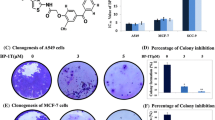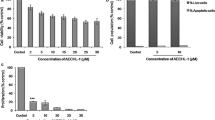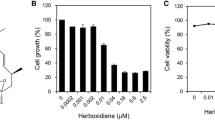Abstract
Benzophenones and its analogues are known for wide range of biological properties. Synthetic benzophenone analogue 2-benzoyl -phenoxy acetamide (BP-1) is proven to be potent antitumor and proapoptotic activity against EAT cells in-vivo. In the present report, we studied the antiangiogenic effect of BP-1 in EAT cells induced angiogenesis. Treatment with BP-1 in-vivo was demonstrated by the down regulation of the secretion of VEGF from EAT cells and inhibition of blood vessels formation indicating the potential angioinhibitory effect of BP-1 in EAT cells. HIF-1α protein, a transcription factor known to be key a regulator in hypoxia-induced angiogenesis was also down regulated by BP-1. Our findings indicated that, HIF-1α nuclear sequestration is repressed by BP-1 through inhibition of nuclear translocation. We postulate that diminished HIF-1α nuclear presence and activity in BP-1 treated EAT cells could be responsible for decreased VEGF expression and antiangiogenic effects.
Similar content being viewed by others
References
Folkman J (1990) What is the evidence that tumors are angiogenesis dependent. J. Natl. Cancer Inst 82:4–6
Kim KJ, Li B, Winner J, Armanini M, Gillett N, Philips HS, Ferrara N (1993) Inhibition of vascular endothelial growth factor-induced angiogenesis suppress tumor growth in-vivo. Nature 362:841–844
Houck KA, Ferrara N, Winer J, Cachianes G, Li B, Leung, DW (1991) The vascular endothelial growth factor family: identification of a fourth molecular species and characterization of alternative splicing of RNA. Mol. Endocrinol 5:1806–1814
Gasparini G, Harris AL (1995) Clinical implications of the determination of tumor angiogenesis in breast carcinoma: much more than a new prognostic tool. J Clin Oncol 13:765–782
Stoelcker B, Echtenacher B, Weich HA, Sztajer H, Hcklin DJ, Mannel DN (2000) VEGF/Flk-1 interaction, a requirement for malignant ascites recurrence. J Interferon Cytokine Res 20:511–517
Mesiano S, Ferrara N, Jaffe, RB (1998) Role of vascular endothelial growth factor in ovarian cancer: inhibition of ascites formation by immunoneutralization. Am J Pathol. 153:1249–1256
Yukita A, Asano M, Okamoto T, Mizutani S, Suzuki H (2000) Suppression of ascites formation and re-accumulation associated with human ovarian cancer by anti-VPF monoclonal antibody in- vivo. Anticancer Res 20:445–454
An WG, Kanekal M, Simon MC, Maltepe E, Blagosklonny MV, Neckers LM (1998) Stabilization of wild type p53 by hypoxia inducible factor 1-α. Nature 392:405–408
Sivridis E, Giatromanolaki A, Gatter KC, Harris AL, Koukourakis MI (2002) Association of hypoxia-inducible factors 1α and 2α with activated angiogenic pathways and prognosis in patients with endometrial carcinoma. Cancer 95:1055–1063.
Brown JM: Exploiting the hypoxic cancer cell (2000) mechanism and therapeutic stratergies. Mol Med Today 6:157–162
Kung AL, Wang S, Klco JM, Kalein WG, Livingston DM (2000) Supression of tumor growth through disruption of hypoxia inducible transcription. Nat Med 6:1335–1340
Warbrug O (1956) On the origin of cancer cells. Science 123:309–314
Harris JW, Meyskens F, Patt HM (1962) Biochemical studies of cytokinetics changes of tumor growth. Cancer Res 30:509–519
Gekeler V, Epple Kleyman J, Probst H (1993) Selective synchronous activation of early S-phase replicons of Ehrlic ascites cells. Mol Cell Biol 13:5020–5033
Probst H, Schiffer H, Gekeler V, Kienzle-Pfeilsticker H, Stropp U, Stotzer KE, Frenzel-Stotzer I (1998) Oxyegen depedent regulation of DNA synthesis and growth of Ehrlich ascites tumor cells in-vitro and in-vivo. Cancer Res 48:2053–2060
Buchler P, Reber HA, Buchler MW, Friess H, Lavey HRS, Hines OJ (2004) Antiangiogenic activity of genistien in pancreatic carcinoma cell is mediated by the inhibition of Hypoxia inducible factor-1 and the down regulation of VEGF gene expression. Cancer 100:201–210
Graeber TG, Osmanian C, Jacks T, Housman DE, Koch CJ, Lowe SW, Giaccia AJ (1996) Hypoxic mediated selection of cells with diminished apoptotic potential in solid tumors. Nature 379:88–91
Magnusson KP, Satalino R, Qian W, Klein G, Wiman KG (1996) Is conversation of solid into more anoxic ascites tumor associated with p53 inactivation? Oncogene 17:2333–2337
Helmlinger G, Yuan F, Dellian M, Jain RK (1997) Interstitial pH and pO2 gradients in solid tumors in-vivo: High-resolution measurement reveal a lack of correlation. Nat Med 3:177–182
Inoue M, Mukai M, Hamanaka Y, Tatsuta M, Hiraoka M, Kondoh S (2004) Targetting hypoxic cancer cells with a protein prodrug is effective in experimental malignant ascites. Int J Oncology 25:713–720
Henry Jacobs GE, Carrington CMS, McLean S, Freeholds W (1999) Prenylated benzophenone derivatives from Caribbean Clusia species (Guttiferae). Plukenetiones B-G and xerophenone A. Tetrahedron 55:1581–1596
Karrer F, Meier H, Pascual A (2000) Short synthesis of 4-chloro- 4′-(chlorodifluoromethoxy) benzophenone. J Flour Chem 103:81–84
Sheu SY, Tsai HJ, Chiang HC (1999) Benzophenones as xanthine oxidase inhibitors. Anticancer Res 19:1131–1135
Burns DT, Tungkananuruk N, Thuwasin S (2000) Spectrophotometric determination of bismuth after extraction of tetrabutylammonium tetraiodobismuthate(III) with microcrystalline benzophenone. Anal Chim Acta 419:41–44
Kumazawa E, Hirotani K, Clifford Burford S, Kawaagoe K, Miwa T, Mitsui I, Ejima A (1997) Synthesis and antitumor activity of novel Benzopheneone derivatives. Chem Pharm Bull 45:1470–1474
Tanaka T, Kohno H, Shimada R, Kagami S, Yamaguchi F, Kataoka S, Ariga T, Murakami Koshimizu K, Ohigashi H (2000) Prevention of colonic aberrant crypt foci by dietary feeding of garcinol in male F344 rats. Carcinogenesis 21:1183–1189
Hsieh HP, Liou JP, Lin YT, Mahindroo N, Chang JY, Yang YN, Chern SS, Tan UK, Chang CW, Chen TW, Lin CH, Chang YY, Wang CC (2003) Structural activity and crystallographic analysis of benzophenone derivatives-the potential anticancer agents. Bioorg Med Chem Lett 13:101–105
Ito C, Itoigawa M, Miyamoto Y, Onoda S, Rao KS, Mukainaka T, Tokuda H, Nishino H, Furukawa H (2003) Polyprenylated benzophenones from Garcinia assigu and their potential cancer chemo preventive activities. J Nat Prod 66:206–209
Matsumoto K, Akao Y, Kobayashl E, Ito T, Ohgucih T, Tanaka T, Inuma M, Nozawa Y (2003) Cytotoxic benzophenone derivatives from garcinia species displays a strong apoptosis inducing effect against human leukemia cell lines. Biol Pharm Bull 26:569–571
Liuo JP, Chang CW, Song JS, Yang YN, Yeh CF, Tseng HY, Lo YK, Chang YL, Chang CM, Haiesh HP (2002) Synthesis and structure activity relationship of 2-aminobenzophenone derivatives as antimitotic agents. J Med Chem 45:2556–2562
Liekens S, Clercq ED, Neytes J. Angiogenesis (2001) regulator and clinical applications. Biochemical pharmacology 61:253–270
Prabhakar BT, Khanum SA, Jayashree K, Salimath BP, Shashikanth S: Anti-tumor and proapoptotic effect of novel synthetic benzophenone analogues in Ehrlich ascites tumor cells. Bioorg.Med.Chem. 2005 (Article in press)
Folkman J. (2000) Tumor angiogenesis. In: Holland JF, Frei E III, Bast RC, Jr, Kufe DW, Pollock RE, Weichselbanm RR (eds) Cancer medicine, 5th ed. Canada, BC, Decker Inc. 132–152
Folkman J (2001) Angiogenesis In: Braunwald E, Fauci AS, Kasper DL, Hauser SL, Longo DL, Jameson JL (eds.), Harrison’s textbook of internal medicine. 15th ed. New York: McGraw–Hill: 517–530
Luo JC, Yamaguchi S, Shinkai A, Shitara K, Shibuya M (1998) Significant expression of vascular endothelial growth factor/vascular permeability factor in mouse ascites tumors. Cancer Res 58:2652–2660
Senger DR, Perruzzi CA, Feder J, Dvorak HF (1986) A highly conserved vascular permeability factor secreted by a variety of human and rodent tumor cell lines. Cancer Res 46:5629–5632
Nagy JA, Morgan ES, Herzberg KT, Meyers MS, Yeo KT, Sioussat TM (1995) Pathogenesis of ascites tumor growth: vascular permeability factor, vascular hyperpermiability, and ascites fluid accumulation. Cancer Res 55:360–368
Mesiano S, Ferrara N, Jaffe RB (1998) Role of vascular endothelial growth factor in ovarian cancer. Inhibition of ascites formation by immunoneutralization. Am J Pathol 153:1249–1256
Kim KJ, Li B, Winer J, Armanini M, Gillett N, Phillips HS, Ferrara N (1993) Inhibition of vascular endothelial growth factor induced angiogenesis suppresses tumor growth in-vivo. Nature 362:841–844
Borgstrom P, Hillan, KJ, Sriramarao P, Ferrara N (1996) Complete inhibition of angiogenesis and growth of microtumors by anti-vascular endothelial growth factor neutralizing antibody, novel concept of angiostatic therapy from intravital videomicroscopy. Cancer Res 56:4032–4039
Blagosklonny MV (2001) Hypoxia-inducible factor: Achilles’ heel of antiangiogenic cancer therapy. Int J Oncol 19:257–262
Vaupel P, Kallinowski F, Okunieff P (1989) Blood flow, oxygen, and nutrient supply and metabolic microenvironment of human tumors: a review. Cancer Res 49:6449–6465
Kizaka-Kondoh S, Inoue M, Harada H, Hiraoka, M (2003) Tumor hypoxia: a target for selective cancer therapy. Cancer Sci 94:1021–1028.
Author information
Authors and Affiliations
Corresponding author
Rights and permissions
About this article
Cite this article
Prabhakar, B.T., Khanum, S.A., Shashikanth, S. et al. Antiangiogenic effect of 2-benzoyl–phenoxy acetamide in EAT cell is mediated by HIF-1α and down regulation of VEGF of in-vivo . Invest New Drugs 24, 471–478 (2006). https://doi.org/10.1007/s10637-006-6587-0
Published:
Issue Date:
DOI: https://doi.org/10.1007/s10637-006-6587-0




